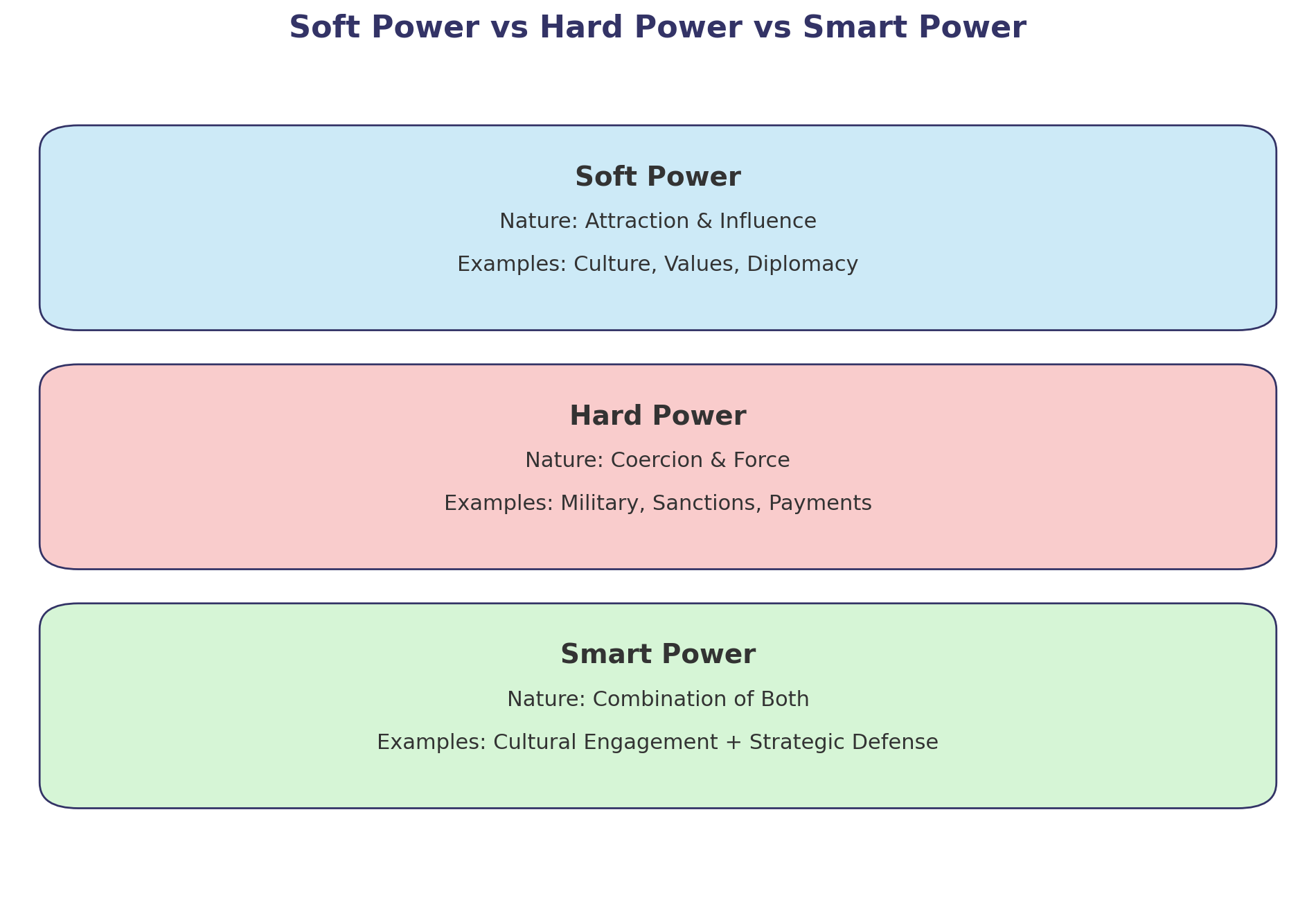
19 Jul Hard Power in International Relations
Hard Power in International Relations – UPSC CSE GS Paper 2
Hard Power is a fundamental concept in International Relations (IR) and a key part of the IR syllabus for UPSC CSE. It refers to a country’s ability to influence others through force, threats, or economic incentives. This power is tangible and coercive in nature, unlike Soft Power, which is based on attraction and cultural influence.
What is Hard Power?
The term “Hard Power” was popularized by political scientist Joseph Nye. It describes a state’s use of military or economic means to influence the behavior or interests of other political entities.
Core Features of Hard Power:
- Coercive: Relies on force, fear, and deterrence.
- Tangible Assets: Includes military strength, weaponry, economic sanctions, and aid.
- Short-Term Impact: Effective in compelling immediate compliance.
- Zero-Sum Nature: One actor’s gain often comes at another’s loss.
Examples of Hard Power
- Use of military intervention (e.g., US invasion of Iraq).
- Imposition of economic sanctions (e.g., sanctions on Russia or Iran).
- Defense alliances (e.g., NATO operations).
- Military drills and presence (e.g., Quad naval exercises).
- Economic aid tied with political strings.
India and Hard Power
India, traditionally known for soft power diplomacy, has increasingly adopted hard power tools in recent decades. This shift is a response to evolving security threats and regional power dynamics.
Hard Power Elements in India’s Foreign Policy:
- Military Modernization: Strengthening of Indian Armed Forces and strategic capabilities.
- Nuclear Deterrence: India’s credible minimum deterrence and No First Use policy.
- Balakot Airstrike (2019): Assertive response to terrorism.
- Border Defense: LAC tensions with China and LoC with Pakistan.
- Defense Diplomacy: Joint military exercises (Malabar, Yudh Abhyas).
Hard Power vs Soft Power vs Smart Power
| Aspect | Hard Power | Soft Power | Smart Power |
|---|---|---|---|
| Definition | Influence through coercion | Influence through attraction | Combination of both |
| Tools | Military, sanctions, aid | Culture, diplomacy, values | Strategic use of both |
| Nature | Immediate & forceful | Gradual & persuasive | Context-specific mix |
Benefits of Hard Power
- Quick Response: Useful in dealing with terrorism, aggression, and conflict.
- Deterrence: Prevents hostile actions by showcasing strength.
- Strategic Leverage: Increases bargaining power in international negotiations.
- National Security: Protects sovereignty and borders.
Criticism and Limitations
- May lead to long-term instability (e.g., Iraq, Afghanistan).
- Expensive and resource-intensive.
- Damages global image and soft power capital.
- Short-term compliance, not lasting cooperation.
- Escalates regional arms race and insecurity.
UPSC Previous Year Questions (PYQs) related to Hard Power
- 2021: “India’s national security strategy needs a balance between hard and soft power.” Discuss.
- 2019: “Hard power is essential but insufficient in the globalized world.” Explain.
- 2016: Analyze India’s defense diplomacy in light of regional power shifts.
Probable Questions for UPSC Mains
- Examine India’s use of hard power tools in its neighborhood policy.
- Discuss the relevance of hard power in India’s Act East and Indo-Pacific strategies.
- Compare and contrast India’s military diplomacy with that of China in the Indian Ocean Region.
Conclusion
Hard Power is indispensable for safeguarding national interests, ensuring territorial integrity, and projecting strength in a volatile global order. However, relying solely on it can erode credibility and alienate partners. For India, a calibrated use of hard power—complemented by its strong soft power base—represents the essence of a smart power strategy.
Keywords:




No Comments